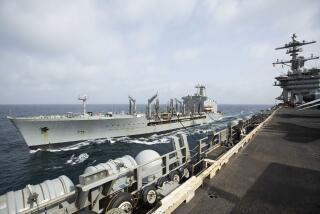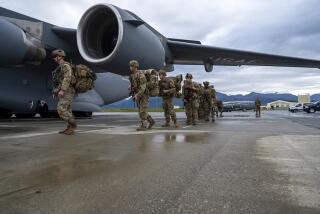At grounded Alaska oil rig, response crews on tense standby
- Share via
Coast Guard emergency teams continue to wait and watch a grounded oil rig in southern Alaska on Wednesday morning for signs of leakage. Stormy weather is delaying efforts to get people onto the Kulluk rig to make a closer assessment. Meanwhile, a “full-scale” response operation is being marshaled -- just in case.
“There’s no sign of any leakage,” Coast Guard spokesman Sam Sacco told the Los Angeles Times on Wednesday. “Just as a contingency, a full-scale response operation is being put in place, but the fact is, there is no leakage of chemicals into the water.”
Sacco said that multiple flyovers of the rig have taken place, which have led authorities to determine that the rig is stable. But as soon as the weather allows, he said, they plan “to actually fly people in and land them back on that rig.”
As the Los Angeles Times reported, there were two attempts Tuesday to do just that, but they failed because of winds that were gusting up to 80 mph and seas of more than 40 feet.
The Kulluk offshore drilling rig became beached Friday on a remote island in southern Alaska. The Kulluk had more than 150,000 gallons of fuel and other petroleum products on board.
“Right now … the Kulluk [rig] is sound. There is no sign of a breach of the hull; there is no sign of release of any product,” U.S. Coast Guard Capt. Paul Mehler, the federal on-scene commander for what was becoming a major response effort, said at a news conference Tuesday.
The 266-foot conical rig, which recently completed an inaugural season drilling the beginnings of an exploratory well for Shell in the Beaufort Sea, was rocking slowly in the turbulent surf off Sitkalidak Island, near a remote area known as Ocean Bay, just off southern Kodiak Island.
According to officials with the Alaska Department of Environmental Conservation, environmental response teams were moving in from as far away as Homer and Seward to monitor possible threats to the water and wildlife.
The area lies near critical habitat for Steller sea lions, protected under the federal Endangered Species Act, and is also near habitat for seabirds known as Steller’s eiders and a number of salmon species, state officials said.
The incident occurred as the Kulluk was being towed south from Dutch Harbor, Alaska, last week. Its main tow line and emergency line detached from the vessel hauling it as a result of heavy winds and high seas. Then the engines failed on the towing vessel. The weather stymied further attempts to reestablish a tow.
Conservation groups said the incident raised questions about how well Shell Alaska could have responded if the incident had happened not near Kodiak, where the Coast Guard operates a major base, but 1,000 miles north where drilling operations were underway in the Arctic.
“We are learning, again and again, that Alaska’s seas are unforgiving. More careful preparation and planning clearly are needed before decisions are made to allow offshore oil and gas activities in the Arctic Ocean,” the conservation group Oceana, which has opposed offshore drilling in Alaska, said in a statement. “Substantial public resources have been—and will be—expended as a result of Shell’s choices. The American public deserves to know how those choices were made and whether accidents like this can be prevented.”
ALSO:
Fighting for a World War I memorial
Pinnacles finally getting “recognition it deserves”
Deadly Oregon bus crash sparks federal investigation
More to Read
Sign up for Essential California
The most important California stories and recommendations in your inbox every morning.
You may occasionally receive promotional content from the Los Angeles Times.











